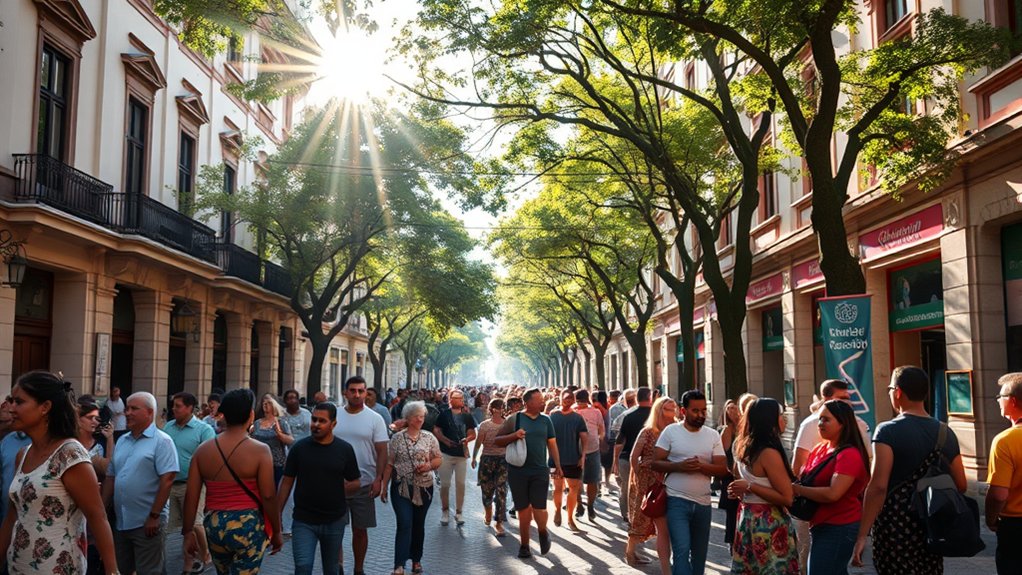Latin America’s cultural mosaic reveals a fascinating puzzle: which nation bears the strongest European imprint? While several countries stake their claim, Argentina emerges as a compelling frontrunner with its unmistakably European essence. From Buenos Aires’ Parisian-style boulevards to the Italian-influenced cafe culture, the European DNA runs deep through Argentine society. Yet this seemingly straightforward question opens up a more nuanced exploration of what truly defines “European-ness” in the Americas.
Key Takeaways
- Argentina has the highest European ancestry in Latin America, with 97.2% of its population having European heritage, primarily Spanish and Italian.
- Genetic studies confirm Argentina’s strong European connection, showing 79.9% European ancestry in its population’s genetic makeup.
- Uruguay follows closely with approximately 87% of its population claiming European ancestry, heavily influenced by Italian and Spanish immigration.
- Buenos Aires, Argentina’s capital, is known as the “Paris of South America” due to its European architectural style and cultural atmosphere.
- Both Argentina and Uruguay experienced massive European immigration waves during the late 19th and early 20th centuries, fundamentally shaping their demographics.
The Historical Context of European Settlement in Latin America

While the European colonization of Latin America is often viewed through the lens of Spanish and Portuguese conquests, the reality encompassed a far more intricate fabric of cultural, demographic, and social changes. The arrival of Europeans in 1492 triggered a chain of events that would permanently alter the continent’s terrain.
The story wasn’t simply about conquest – it was about the clash and eventual interweaving of worlds. As European settlers established new cities and trading routes, indigenous resistance emerged alongside unprecedented population decline, with some estimates suggesting an 80% reduction in native populations. The resulting social hierarchy placed Europeans at the apex, yet the cultural exchange proved unavoidable. From the Amazon to the Andes, European and indigenous traditions merged, creating unique hybrid societies that would later form the foundation of modern Latin American nations. The Columbian Exchange reshaped economies through an unprecedented transfer of crops, goods, and diseases between the Old and New Worlds.
Argentina: A Case Study in European Heritage
Argentina stands as Latin America’s most compelling example of extensive European influence, with a demographic composition that rivals many European nations themselves. This cultural syncretism emerged through massive immigration waves between 1857 and 1940, fundamentally shaping the nation’s ethnic identity. The impact of European heritage manifests in three distinct ways:
- Population demographics showing an unprecedented 97.2% European connection, primarily Spanish and Italian
- Linguistic evolution featuring Spanish with strong Italian influences, particularly in the distinctive porteño accent
- Economic development patterns following European settlement, especially in agricultural regions
The alteration was so profound that Argentina’s cultural terrain became a unique fusion of European traditions, particularly evident in its institutions, language, and social customs, distinguishing it from other Latin American nations. Recent genetic studies reveal an average of 79.9% European ancestry in the Argentine population, confirming its status as the most European country in Latin America.
Uruguay’s Strong European Identity
Uruguay’s remarkable European identity stems from the massive waves of Italian and Spanish immigrants who arrived during the 19th and early 20th centuries, fundamentally shaping the nation’s demographic makeup. These European settlers, who came seeking better opportunities, brought with them rich cultural traditions that have been carefully preserved through subsequent generations, from architecture and cuisine to social customs and religious practices. The continued influence of this European heritage remains evident today, with an estimated 87% of Uruguay’s population claiming European ancestry – a reflection of the enduring impact of those initial immigration patterns and the successful transmission of cultural values across time. The distinctive Rioplatense Spanish dialect spoken throughout the country clearly demonstrates the lasting Italian influence on Uruguayan culture.
European Immigration Patterns
The transformative waves of European immigration that shaped Uruguay’s identity began with the Spanish conquest in the 16th century and reached their pinnacle between 1860 and 1920, when more than 600,000 Europeans made the South American nation their home. These immigration waves fundamentally altered the country’s demographic terrain, with cultural integration occurring naturally as newcomers established their communities.
The most significant European immigrant groups included:
- Italians, who became the largest immigrant population, leaving an indelible mark on local cuisine and culture
- Spaniards, who bolstered the existing Hispanic heritage while introducing new customs
- French settlers, who came to represent roughly 10% of the population, contributing to the nation’s architectural and cultural sophistication
This European influx established Uruguay’s distinctive cosmopolitan character, setting it apart from its South American neighbors. By 1908, the impact of this migration was clearly evident as foreign-born individuals represented 17% of the total population.
Cultural Preservation Through Generations
Building upon the foundation laid by early European settlers, generations of Uruguayans have masterfully preserved their distinct cultural identity through a remarkable blend of Old World traditions and New World innovations. This cultural resilience manifests in the nation’s vibrant festivals, architectural heritage, and educational values, where European influences seamlessly merge with local customs.
Through generational storytelling and a robust commitment to literacy, Uruguayans maintain their connection to European roots while embracing contemporary global influences. The country’s extensive network of public libraries, thriving artistic scene, and dedication to cultural preservation showcase this dynamic balance. From the cobblestone streets of Colonia del Sacramento to modern Montevideo’s cosmopolitan atmosphere, Uruguay’s European heritage remains evident, yet continues to evolve through each generation’s interpretation and adaptation of these cherished traditions. The nation’s recent accession to UNIDROIT further demonstrates its unwavering dedication to protecting and preserving its rich cultural heritage for future generations.
Cultural Markers of European Influence
The European architectural legacy in Latin America stands as a representation of colonial influence, with grand cathedrals, ornate government buildings, and elegant town squares gracing cities from Buenos Aires to Lima. Religious traditions imported from Europe, particularly Catholic celebrations and festivals, have become deeply woven into the cultural fabric of Latin American society, creating unique hybrid expressions of faith and festivity. These architectural and religious markers continue to shape daily life, from the morning bells of colonial-era churches to the evening promenades along European-styled boulevards, illustrating how thoroughly European cultural elements have been incorporated into Latin American identity. The adoption of European fashion and social customs reflected the period’s cultural imperialism, with wealthy Latin Americans embracing top hats and canes as symbols of sophistication.
Architectural Heritage and Design
Throughout Latin America’s vibrant cityscape, European architectural influences have left an indelible mark that transcends mere aesthetic appeal. From Spanish Colonial structures to French-inspired urban aesthetics, the continent’s buildings tell a story of cultural fusion and architectural evolution. This rich heritage manifests in diverse architectural styles, seamlessly blending European grandeur with indigenous materials and local sensibilities. The rise of Baroque architecture became particularly prominent in religious buildings, showcasing elaborate ornamentation and dramatic designs.
Key European influences that shaped Latin American architecture include:
- Spanish Colonial design with its characteristic flat roofs and ornate decorations
- French and Italian Neo-Classical elements prominent in civic buildings and urban squares
- Moorish-inspired details reflecting the sophisticated blend of European and Arabic aesthetics
This architectural fabric continues to define Latin American cities, where European-influenced designs adapt and thrive alongside modern innovations, creating unique urban identities that honor both colonial heritage and independent spirit.
Religious Customs and Celebrations
While architectural heritage visibly marks European influence across Latin America, religious customs and celebrations reveal an even deeper cultural imprint that shapes daily life and spiritual expression. The strong romanization of religious practices during the nineteenth century heavily impacted worship traditions. The region’s religious festivals showcase a fascinating blend of European Catholic traditions with indigenous and African elements, creating distinct forms of cultural syncretism. From the solemn processions of Semana Santa to the festive Fiestas Patronales, these celebrations echo European origins while embracing local interpretations. Catholic iconography, particularly in religious art and ritual practices, demonstrates this dual heritage – European saints and madonnas share space with symbols like the Virgin of Guadalupe. The influence of European liturgical customs remains strong in baptisms, weddings, and funeral services, though often adapted through a uniquely Latin American lens.
Demographic Patterns and Immigration Waves
During the late 19th and early 20th centuries, Latin America experienced massive waves of European immigration that fundamentally altered its demographic terrain, with an estimated 13 million Europeans seeking new opportunities across the region. These demographic shifts were particularly pronounced in countries like Argentina and Uruguay, where migration motivations ranged from economic opportunities to political freedom.
Three key factors shaped this change:
Major forces drove Latin America’s transformation through European migration: post-war exodus, economic pressures, and deep cultural integration.
- Post-WWII European exodus brought skilled workers and entrepreneurs
- Economic crises in Europe drove continued immigration waves through the 20th century
- Cultural integration led to lasting European influences in language, customs, and traditions
Today, this heritage remains evident in the region’s population distribution, with Argentina and Uruguay standing out for their strong European demographic characteristics and cultural practices, reflected in everything from their architecture to their daily customs. Modern migration patterns show increased EU migration to Latin America, with more Europeans moving to the region than Latin Americans to Europe for the first time in 14 years.
Architectural Legacy and Urban Planning

Latin America’s architectural identity stands as a reflection of its profound European influences, particularly visible in the grand boulevards of Buenos Aires and the colonial plazas of Lima. The continent’s urban settings mirror European design principles, from grid-patterned streets to monumental government buildings inspired by neoclassical and baroque styles.
Throughout major cities, architectural styles reflect a fascinating blend of Spanish colonial heritage, Moorish influences, and post-independence European aesthetics. Art Nouveau facades grace theater houses, while Neo-Mudéjar details adorn public buildings. The influence of Spain’s Islamic architecture is especially evident in buildings like the Casa Román in Cartagena, which showcases distinctive Alhambra-inspired designs. This European architectural DNA isn’t merely superficial – it’s woven into the fabric of Latin American urbanism, from UNESCO-protected historic centers to modern civic spaces. Cities like Buenos Aires, with its Parisian-style apartments and Spanish colonial churches, exemplify this enduring European architectural legacy.
Language and Linguistic Evolution
While Spanish and Portuguese dominate Latin America’s linguistic terrain, their evolution across different regions reveals fascinating variations shaped by local influences. The emergence of distinct dialects reflects not only the colonial legacy but also the rich interplay between European romance languages and indigenous tongues. This linguistic fusion has created unique regional expressions and vocabularies, making each country’s version of these European languages distinctly their own, even as they maintain their romance language roots. Today, approximately 450 languages of indigenous origin further enrich this linguistic tapestry across the region.
Romance Language Dominance
Romance languages swept through Latin America like linguistic conquistadors, establishing an unprecedented dominance that persists to this day. This linguistic upheaval altered the continent, with Spanish and Portuguese becoming the primary vehicles of communication across vast territories. The implementation of bilingual education programs further solidified this Romance language dominance, creating a unique cultural bridge between the Old and New Worlds. The spread of these languages can be traced back to when Vulgar Latin evolved into distinct Romance languages during the post-Roman Empire period.
Key aspects of this linguistic alteration include:
- Spanish emerged as the dominant language, with over 489 million native speakers across Latin America
- Portuguese established itself firmly in Brazil, becoming the language of 240 million individuals
- These languages evolved distinct regional characteristics while maintaining their Romance roots
This linguistic heritage has created a powerful cultural connection between Latin America and Southern Europe, influencing everything from literature to governance.
Indigenous Language Influence
Beneath the blanket of Romance languages that covers the continent lies a rich fabric of indigenous languages that shapes the linguistic terrain of South America. With over 600 living indigenous languages, from the widely-spoken Quechua to the endangered tongues of the Amazon, these linguistic treasures tell a story of cultural preservation spanning millennia. Nahuatl and Quechua demonstrate remarkable resilience among native languages across Latin America, connecting millions to their ancestral heritage.
The geographical isolation of communities has fostered remarkable diversity, with each region developing distinct linguistic features. While Quechua echoes through the Andean highlands and Guarani flourishes as Paraguay’s pride, countless other languages face the challenge of survival. Modern efforts to protect these languages through official recognition and bilingual education programs reflect a growing understanding that indigenous languages aren’t just communication tools – they’re living repositories of ancestral wisdom and cultural identity.
Social Customs and Daily Life
Uruguayan social customs blend European sensibilities with Latin American warmth, creating a unique cultural fabric that sets the nation apart from its neighbors. Daily routines revolve around social gatherings, with mate-sharing rituals and Sunday asados forming the cornerstone of community life. Personal interactions feature closer physical proximity and direct communication, while maintaining a distinctly modest approach to social relations. The nation’s open-minded local population makes it particularly welcoming for newcomers seeking to establish social connections.
Key aspects of Uruguayan social life include:
- Traditional greetings combining hugs and cheek kisses, reflecting a balance of formality and warmth
- Strong emphasis on family time, particularly during Sunday gatherings and festivals
- A sophisticated urban culture that welcomes both tango halls and modern cafes
This harmonious fusion of European refinement and Latin American sociability creates an atmosphere where community connections thrive naturally and authentically.
Economic Systems and European Parallels
While Latin American economies have developed their own distinct characteristics over time, their fundamental structure bears a striking resemblance to European economic systems, particularly in areas of trade integration and financial governance. The region’s economic policies have historically mirrored European models, from the establishment of central banks to the implementation of trade agreements. This alignment intensified during the post-World War II era, with Latin American nations adopting European-style reforms in banking, tariff structures, and foreign investment regulations. Rather than operating as traditional or feudal economies, these nations function as developed market economies integrated within the global capitalist system. The introduction of the euro further strengthened these parallels, enhancing trade efficiency and boosting European demand for Latin American exports. Today, specialized state banks, regulatory frameworks, and financial institutions across Latin America continue to reflect European influences, creating a fascinating hybrid of regional innovation and Old World economic principles.
Genetic Studies and Population Research

Extensive genetic research across Latin America has unveiled fascinating patterns of human diversity, offering unprecedented revelations into the region’s intricate population history. Through comprehensive ancestry mapping initiatives, scientists have discovered remarkable variations in genetic diversity across different countries, reflecting unique historical patterns of European, African, and Native American admixture. The project’s development of the GLAD-match algorithm helps researchers better analyze and compare genetic backgrounds across populations.
- The Genetics of Latin American Diversity Project has analyzed over 53,000 individuals, creating the most extensive genetic database of the region.
- Population structures vary significantly by country, with some nations showing predominantly European ancestry.
- Studies consistently reveal sex-biased admixture patterns, typically involving European male ancestors and Native American or African female ancestors.
This genetic mosaic provides vital understandings for determining which Latin American nations have maintained the strongest European genetic signatures while celebrating their unique multicultural heritage.
Modern European Connections and Diplomacy
Beyond historical colonial ties, modern relationships between Latin America and Europe have evolved into dynamic partnerships spanning economic, cultural, and diplomatic spheres. The EU’s diplomatic strategies have crystallized through strategic partnerships with powerhouses like Brazil and Mexico, while cultural initiatives flourish through scholarship programs and artistic collaborations. Relations have experienced notable stagnation periods since the late 1990s despite ongoing diplomatic efforts.
The EU’s Global Gateway Strategy exemplifies this modernized approach, focusing on sustainable development and digital evolution across Latin America. Regular EU-LAC summits since 1999 have strengthened these bonds, while the Euro-Latin American Parliamentary Assembly serves as a vital bridge between the regions. European companies increasingly invest in Latin American renewable energy projects, demonstrating how traditional relationships have shifted into forward-looking partnerships focused on shared global challenges and mutual prosperity.




10 Responses
This article is biased. It only talks about Argentina and Uruguay, ignoring other countries like Chile and Peru that also have European roots.
‘Paris of South America’? That’s just a marketing slogan! Buenos Aires has its own unique culture separate from Europe.
‘Cultural syncretism’ is cool, but let’s not forget that this blending can erase other important histories. It’s complicated!
I don’t get why everyone keeps saying Argentina is the most European. What about Brazil? They have a lot of European influence too!
The focus on genetic studies seems misleading. Does having European ancestry define a country’s culture? I think that’s too simplistic.
If the majority of people in Argentina are European, does that mean they’ve lost their indigenous culture? Seems like a problem to me.
‘European-ness’? What does that even mean? Cultures are more complex than just who your ancestors were!
‘Cultural preservation’ sounds great, but what about the impact on indigenous populations? Their stories matter too!
‘Massive waves of immigration’ happened everywhere in Latin America! Why does Argentina get all the attention?
‘Economic parallels’ to Europe make it sound like Latin American countries are just copies. They’re so much more than that!